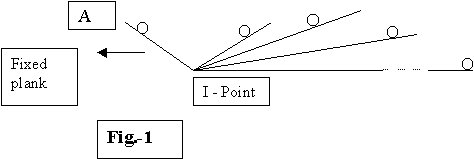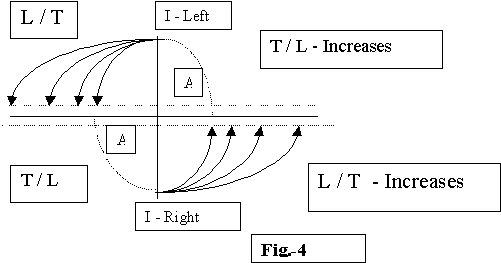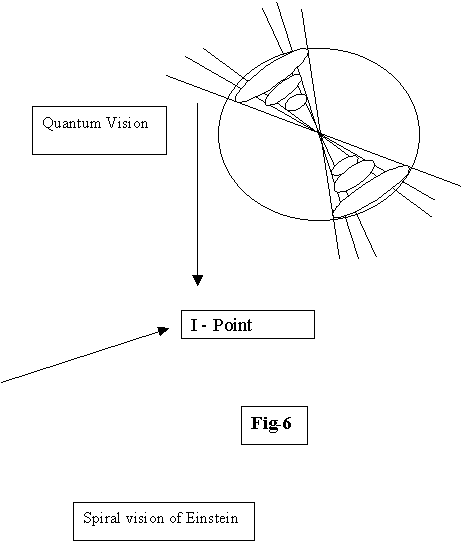
Secret of Friction
Relation Between the Path and Quantum Motion
Discovering “I” and the Journey from Darkness to Light

Friction
is the pivotal stone on which nature exists. Understanding friction
therefore could lead us to the secret of nature and its existence –
that is to the cycle of beginning, end and new beginning.
Galileo laid the foundation of science by carefully putting a veil on this important aspect of nature. In order to conquer the fundamental phenomenon of nature, that is motion; in to predictable mathematical formulae he assumed a platform that has no friction. What he did in the process was to imprison his own senses and intuition and thereby the reality of nature and give vent to his negative or conquering motives. It is important that we recall the argument of the father of science whom we still fallow blindly.

The
fig. –1 shows the experiment on which Galileo argued and built the
foundation to science. The ball rolled on the fixed plank, rolled
farther and farther when the slope was decreased on the right hand side.
He argued that the ball traveled farther and farther because friction
was reduced and that if no friction exists the ball would move
continuously in a straight line forever. Common sense tells us that this
experiment has some flaws
1]
It has certain limits.
2]
The smooth expression of the experiment needs a curved segment at the
transition point [I- Point] between the left and the right.
Sensible
thinking tells us that nature around us is cyclic. All natural motion we
witness in nature is cyclic. It is built on curved components. The most
appropriate thinking therefore should have been to imagine the above
experiment in the form of curvature see fig.-2

This
transition brings up some great difference between the first and the
second.
1]
In the second case Infinity is wiped out. The ball would return to the
starting point the moment the external force is removed. This starting
point invariable is the I- point
2]
In the second case continued and steady motion of the ball need
continued and steady application of external force from “I” point to
overcome the friction of the curve.
3] The moment external force applied is removed the forces gets directed to the center point “I” see fig –2 and 3

4]
In the first case force is assumed to be acting from the point “A”.
In the second case the force is originating from “I” point or the
transition point.
5]
In the first case when force is increased
speed increases but the path does not change.
But in contrast in the second case the path experiences a stress.
The speed in the second case is expressed as revolutions per unit of
choice.
Here
we must note that friction does not arise if the path changes in
relation to the increase in speed. However, this is not possible. Here
we must note that when the path in the direction of the force
experiences a positive expansive stress, then two fixed components
experiences a contractile stress. The component opposite to the
direction of force experiences negative expansive stress. See fig.-4
As
it reaches certain critical ratio 3:1 the system breaks down and the two
left and right components twist in opposite direction and rejoins into a
new order – expanded or contracted depending on the force. See fig -5


What
we must note here is the time and length relation or the ratio in the
four components of the cycle.
1]
In the two paths [in the direction of force and opposite to it] the
paths get expanded and time decreases. In contrast, in the two
intermediate components path gets constricted and the time increases.
This means when in one pair of path speed increases with decrease of
friction, in other two paths speed decreases because of the increase in
friction.
2]
There is a second friction that is related to the distortion of the path
it self. Since the path is twisting the angle between the expanding and
contracting path is decreased. This adds to the friction.
As
the relation touches certain critical limit the system breaks down
reorients in to an expanded state or the acceleration of the system
increases. In other words, the revolution per chosen unit time shows a
quantum increase. The critical limit is 3:1.
Now
let us see what happens if we put the ball out side the path and put the
“I” point inside. Here the ball by its weight or gravity should
bring a spiral sinking depression in the path. This invariably should
also develop an opposite twisted depression on the other side. Now our
picture of the whole is that of a two funnels placed by its tip touching
each other with spiral paths that lead to the “I” - Point see fig-6.
There are two “I” points
that propel the revolution. But when extended back in time the two
“I” point form into one and then differentiates into two only to
return to the union point again. This is applicable to an atom and to
the universe as whole. This means the so-called duality and monism are
two sides of the same coin. The I- Point controls the movement. Every
change should be centered on some point. The universe thus is the
creation of The I- point. All should fallow his change or the path to be
in the universal flow. This
is the Secret of Vedas, The Secret of Jesus Christ and His Second Coming
and other Great Philosophies.

By now the reader should have noted that centuries of conceptual evolution of science from Newtonian, Einsteinian and Quantum mechanical world view is interestingly poised around the action at “I “ point. It is the controlling point of friction. To discover the I - Point in grater detail go through the secret of nature patiently. We must not forget that we live in a gravitational field. This field is quantitative and exists as paths. The strength and the curvature of the path increase in quantum manner as we go away from the center.
Return to Turning point - Paradoxes and Turning Points
Click
her to go to - New
definition to Gravity, Mass, Charge and Field